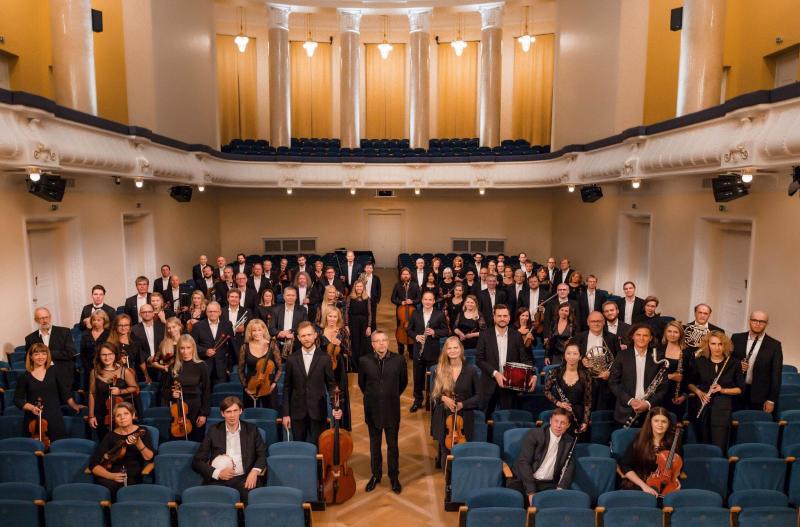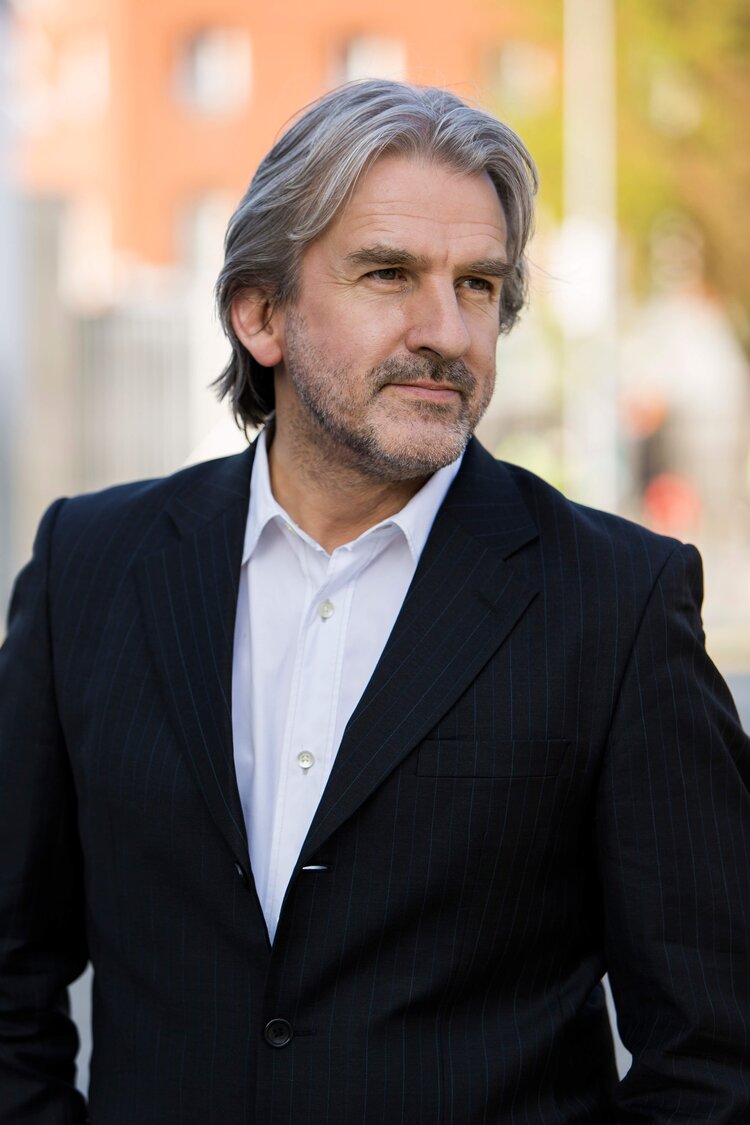Douglas, Estonian NSO, Elts, Cadogan Hall review - perfect ebb and flow from conductor and pianist | reviews, news & interviews
Douglas, Estonian NSO, Elts, Cadogan Hall review - perfect ebb and flow from conductor and pianist
Douglas, Estonian NSO, Elts, Cadogan Hall review - perfect ebb and flow from conductor and pianist
Four glorious works, Thea Musgrave rarity included, plus three encores

Until last night, I’d only heard the Estonian National Symphony Orchestra (ERSO at home, “Riiklik” standing for “National”) live in unfamiliar contemporary epics, with Kristiina Poska and Anu Tali respectively conducting Lepo Sumera’s Fourth and Sixth Symphonies, and Olari Elts just before his 2020 appointment as Music Director championing an Erkki-Sven Tüür triptych. This was a test of how they'd fare in more familiar repertoire. They passed with flying colours.
Arvo Pärt's Cantus to the Memory of Benjamin Britten was the first work by the Estonian master I ever heard in concert, when a then also unknown Neeme Järvi,now the ERSO's Honorary Artistic Director for Life, brought the Gothenburg Symphony Orchestra to London in 1980. It had a massive impact then, and it still does, the overlapping downward scales reaching peak richness in cellos – the ERSO's department is remarkable, led by young world-class soloist Theodor Sink – and basses. Alas for the fool who applauded knowingly before the last bell's echo had died away.
 Complete stillness, fortunately, followed Barry Douglas's encore (the pianist pictured left by Eugene Langan), another lament with scalic passages, this time "October" from Tchaikovsky's The Seasons. It was a chance for Douglas to concentrate on introspective freedom, despite a powerful central climax, after the marathon of Rachmaninov's Third Piano Concerto. What a luxury to feel safe, from the very first stepwise magic, in the hands of an artist who knows exactly how to pace this tricky giant, never lapsing into excess sentimentality and preserving maximum clarity through all the labyrinthine inner lines.
Complete stillness, fortunately, followed Barry Douglas's encore (the pianist pictured left by Eugene Langan), another lament with scalic passages, this time "October" from Tchaikovsky's The Seasons. It was a chance for Douglas to concentrate on introspective freedom, despite a powerful central climax, after the marathon of Rachmaninov's Third Piano Concerto. What a luxury to feel safe, from the very first stepwise magic, in the hands of an artist who knows exactly how to pace this tricky giant, never lapsing into excess sentimentality and preserving maximum clarity through all the labyrinthine inner lines.
There was a sense that Elts and the orchestra were having to catch him at every turn – in that respect it might not have been the most collegial partnership – but they did, with the occasional woodwind solo boding very well for the concert's second half. Sometimes you feel that once-ubiquitous cuts might not be a bad thing; never here. The second half of the long first-movement cadenza raised the emotional game and held to the end of the movement, while the central fantasy of the finale really worked for once. Douglas's task seemed to be to quiet the will-o-the-wisps and petty demons which try to hinder Rachmaninov's progress to triumph.
Why Song of the Enchanter by Scottish composer Thea Musgrave before Sibelius's Fifth Symphony? The answer would have been clear with the embedding in supernatural skirls of the "swan" theme from the symphony's finale even if you didn't know the programme: hero Väinämöinen playing on his five-stringed cantele and weeping tears into the sea which become pearls. Brevity is often an asset in contemporary music, but this enchantment could have lasted for longer. It ends perfectly with the orchestral pianist - here the modestly brilliant Kärt Ruubel - strumming the piano strings into silent infinity.  Even by the benchmarks set in recent interpretations by Finnish conductors, as well as by Elts's compatriot Paavo Järvi with the Estonian Festival Orchestra, this Sibelius Fifth was a beacon of vitality. Elts (pictured above by Priit Murk) has plenty of febrile energy, but never rushes, and knows how to make the big cloudbursts work (as at least one overrated Finn never has). Parallel to Douglas's perfect sense of ebb and flow, this was another experience of total engagement. No wonder one audience member went "wow" after the combined first-movement-and-scherzo drama; we laughed approvingly. The performance also included the most striking take on the central movement I've ever heard. In his first concert with the BBC Symphony Orchestra, Sakari Oramo revealed the full miracle of the comparable "intermezzo" in the Third Symphony, and the dynamics, tempo fluctuations and unexpected colourings of this one were startling in a good way throughout. Full marks to vatic woodwind - the ERSO had the luxury of changing some co-principals after the interval, and clarinettist Soo-Young Lee is a real star – and blazing trumpets.
Even by the benchmarks set in recent interpretations by Finnish conductors, as well as by Elts's compatriot Paavo Järvi with the Estonian Festival Orchestra, this Sibelius Fifth was a beacon of vitality. Elts (pictured above by Priit Murk) has plenty of febrile energy, but never rushes, and knows how to make the big cloudbursts work (as at least one overrated Finn never has). Parallel to Douglas's perfect sense of ebb and flow, this was another experience of total engagement. No wonder one audience member went "wow" after the combined first-movement-and-scherzo drama; we laughed approvingly. The performance also included the most striking take on the central movement I've ever heard. In his first concert with the BBC Symphony Orchestra, Sakari Oramo revealed the full miracle of the comparable "intermezzo" in the Third Symphony, and the dynamics, tempo fluctuations and unexpected colourings of this one were startling in a good way throughout. Full marks to vatic woodwind - the ERSO had the luxury of changing some co-principals after the interval, and clarinettist Soo-Young Lee is a real star – and blazing trumpets.
Much as I love the Estonian Festival Orchestra at Pärnu Music Festival time, there are only so many occasions on which you want to hear Paavo Järvi's legendary encore, Valse triste. This sombre aftermath was one I'd not encountered in the concert hall, "The Death of Mélisande" from Sibelius's incidental music to Maeterlinck's play; it allows for infinite nuance in string playing, rising to a lacerating climax. You could say it was the third work of the evening, following the Pärt and Douglas's Tchaikovsky, to evoke Estonia's grieving but stalwart devotion to the Ukrainian cause. Finally, following a slow hand-clap which denoted the high presence of Estonians in the hall, we got a native crowdpleaser, Tubin's "Dance from Setu", the finale of his Suite on Estonian Dance Tunes. Generous measure, delighted audience.
rating
Explore topics
Share this article
The future of Arts Journalism
You can stop theartsdesk.com closing!
We urgently need financing to survive. Our fundraising drive has thus far raised £49,000 but we need to reach £100,000 or we will be forced to close. Please contribute here: https://gofund.me/c3f6033d
And if you can forward this information to anyone who might assist, we’d be grateful.

Subscribe to theartsdesk.com
Thank you for continuing to read our work on theartsdesk.com. For unlimited access to every article in its entirety, including our archive of more than 15,000 pieces, we're asking for £5 per month or £40 per year. We feel it's a very good deal, and hope you do too.
To take a subscription now simply click here.
And if you're looking for that extra gift for a friend or family member, why not treat them to a theartsdesk.com gift subscription?
more Classical music
 Cho, LSO, Pappano, Barbican review - finely-focused stormy weather
Chameleonic Seong-Jin Cho is a match for the fine-tuning of the LSO’s Chief Conductor
Cho, LSO, Pappano, Barbican review - finely-focused stormy weather
Chameleonic Seong-Jin Cho is a match for the fine-tuning of the LSO’s Chief Conductor
 Appl, Levickis, Wigmore Hall review - fun to the fore in cabaret and show songs
A relaxed evening of light-hearted fare, with the accordion offering unusual colours
Appl, Levickis, Wigmore Hall review - fun to the fore in cabaret and show songs
A relaxed evening of light-hearted fare, with the accordion offering unusual colours
 Lammermuir Festival 2025, Part 2 review - from the soaringly sublime to the zoologically ridiculous
Bigger than ever, and the quality remains astonishingly high
Lammermuir Festival 2025, Part 2 review - from the soaringly sublime to the zoologically ridiculous
Bigger than ever, and the quality remains astonishingly high
 BBC Proms: Ehnes, Sinfonia of London, Wilson review - aspects of love
Sensuous Ravel, and bittersweet Bernstein, on an amorous evening
BBC Proms: Ehnes, Sinfonia of London, Wilson review - aspects of love
Sensuous Ravel, and bittersweet Bernstein, on an amorous evening
 Presteigne Festival 2025 review - new music is centre stage in the Welsh Marches
Music by 30 living composers, with Eleanor Alberga topping the bill
Presteigne Festival 2025 review - new music is centre stage in the Welsh Marches
Music by 30 living composers, with Eleanor Alberga topping the bill
 Lammermuir Festival 2025 review - music with soul from the heart of East Lothian
Baroque splendour, and chamber-ensemble drama, amid history-haunted lands
Lammermuir Festival 2025 review - music with soul from the heart of East Lothian
Baroque splendour, and chamber-ensemble drama, amid history-haunted lands
 BBC Proms: Steinbacher, RPO, Petrenko / Sternath, BBCSO, Oramo review - double-bill mixed bag
Young pianist shines in Grieg but Bliss’s portentous cantata disappoints
BBC Proms: Steinbacher, RPO, Petrenko / Sternath, BBCSO, Oramo review - double-bill mixed bag
Young pianist shines in Grieg but Bliss’s portentous cantata disappoints
 theartsdesk at the Lahti Sibelius Festival - early epics by the Finnish master in context
Finnish heroes meet their Austro-German counterparts in breathtaking interpretations
theartsdesk at the Lahti Sibelius Festival - early epics by the Finnish master in context
Finnish heroes meet their Austro-German counterparts in breathtaking interpretations
 Classical CDs: Sleigh rides, pancakes and cigars
Two big boxes, plus new music for brass and a pair of clarinet concertos
Classical CDs: Sleigh rides, pancakes and cigars
Two big boxes, plus new music for brass and a pair of clarinet concertos
 Waley-Cohen, Manchester Camerata, Pether, Whitworth Art Gallery, Manchester review - premiere of no ordinary violin concerto
Images of maternal care inspired by Hepworth and played in a gallery setting
Waley-Cohen, Manchester Camerata, Pether, Whitworth Art Gallery, Manchester review - premiere of no ordinary violin concerto
Images of maternal care inspired by Hepworth and played in a gallery setting
 BBC Proms: Barruk, Norwegian Chamber Orchestra, Kuusisto review - vague incantations, precise laments
First-half mix of Sámi songs and string things falters, but Shostakovich scours the soul
BBC Proms: Barruk, Norwegian Chamber Orchestra, Kuusisto review - vague incantations, precise laments
First-half mix of Sámi songs and string things falters, but Shostakovich scours the soul
 BBC Proms: Alexander’s Feast, Irish Baroque Orchestra, Whelan review - rapturous Handel fills the space
Pure joy, with a touch of introspection, from a great ensemble and three superb soloists
BBC Proms: Alexander’s Feast, Irish Baroque Orchestra, Whelan review - rapturous Handel fills the space
Pure joy, with a touch of introspection, from a great ensemble and three superb soloists

Add comment